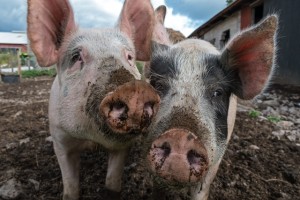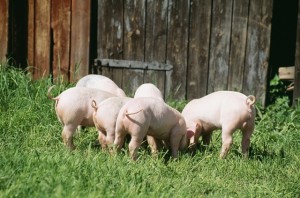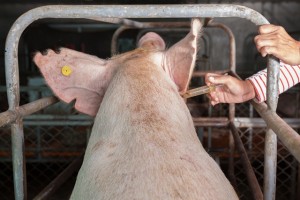Pig Diseases
Colibacillosis in Pigs
Also known as: E. coli infection. Including: Oedema Disease
E. coli infection, or colibacillosis, is a bacterial disease affecting both indoor and outdoor herds, occurring both chronically and sporadically (Potter, 1998). E. coli infections occur at three main stages: neonatal diarrhoea (in the first few days after farrowing), young piglet diarrhoea (from the first week post-farrowing to weaning) and post-weaning diarrhoea (in the first weeks after weaning) (Straw et al, 2006). They can also be present in combination with other pathogens including rotavirus, and cause other diseases such as oedema disease and urinary tract infections (Bertschinger and Fairbrother, 1999; Cowart, 1995).
E. coli from livestock faeces can survive on grass for at least 5-6 months, affording opportunity to contaminate animals, plants or water. E. coli on pasture originating from pigs declines significantly faster than that originating from cattle and sheep (Avery et al., 2004). It is therefore important to move arcs to fresh pasture between uses.
Post-weaning E. coli infection
Nutrition and E. coli infection
Breed resistance and E. coli infection
Control and Prevention
Treatment Options
Good Practice
Neonatal E. coli infection
Infection in neonatal piglets is due to sudden exposure to the bacteria on the skin of the mother, the farrowing hut environment and from other piglets. The excretion rate of E. coli from the sow increases the week following parturition (Goswami et al., 2011; Hampson et al., 1987). Pathogenic E. coli produce a toxin in the intestine that can result in severe fluid loss (scours). Diarrhoea will appear within the first 2-3 hours after infection and can occur in either individual piglets or whole litters (Bertschinger and Fairbrother, 1999). Faeces may be clear or white/yellow/brown. Severe cases result in dehydration, and mortality of up to 70% in piglets affected in the first days of life. This mortality rate rapidly decreases as pigs are affected at later stages (Taylor, 2013; Hall, 1989). Diagnosis requires laboratory testing of gut contents or rectal swabs.
Young piglet diarrhoea (between the neonatal and post-weaning periods)
Pre-weaning piglets, between the ages of 7 and 28 days old, can be affected by a grey or white diarrhoea and become hairy and emaciated, which may result in permanent stunting (Taylor, 2013). Pigs of any age that are fed milk replacer diets or poor quality creep feed, may also be affected by this type of diarrhoea. It rarely affects a whole litter, the larger animals of the litter tend to be worst affected, and many, if not all, litters on the farm can be affected. From 8 days onwards, haemorrhagic gastroenteritis may occur, resulting in sudden death, with or without the passage of brown diarrhoea. The faeces of recovering animals tend to remain white, whilst getting progressively firmer (Taylor, 2013).
Post-weaning E. coli infection

Post-weaning colibacillosis causes watery yellow or grey/brown watery projectile diarrhoea and dehydration. Blood and mucus are rarely present. Once pigs stop receiving maternal antibodies from their mother’s milk, they become susceptible to infections of E. coli acquired from the farm environment.
The weaning of piglets is often associated with digestive disorders, particularly diarrhoea post-weaning colibacillosis (PWC) which is caused by infection with enterotoxigenic strains of E. coli (Montagne et al, 2004). Infections in young and weaned piglets mirror neonatal infections, producing yellowish diarrhoea and dehydration. Feed intake falls significantly, and severe cases show signs of lethargy and disorientation. However, diarrhoea tends to be less severe, and although growth rates may be affected, mortality rates are lower, at around 10% (Taylor, 1995).
Certain serotypes of E. coli cause oedema disease, typically after weaning (Bertschinger and Fairbrother, 1999). Oedema disease, also known as bowel oedema, can occur concurrently with post-weaning diarrhoea. Whereas PWC is a communicable diarrhoea caused by endotoxins, oedema disease is a communicable enterotoxaemia caused by verotoxigenic strains of E. coli (Straw et al, 2006). The protein toxin released by the E.coli enters the bloodstream and damages certain tissues. Oedema of the mesocolon and submucosa of the stomach are frequently seen.
There is a noticeable difference in mortality caused by oedema disease and post-weaning diarrhoea, with the latter averaging 30-40% mortality and oedema disease averaging 50-90% mortality (Straw et al, 2006). In a live pig, diagnosis of oedema disease is based on the sudden appearance of neurological symptoms, most usually ataxia or a staggering gait, 1-2 weeks after weaning. Swelling under the skin of the eyelids and frontal bones are also characteristic (Straw et al, 2006). Please consult your veterinarian for further advice.
Other common causes of piglet diarrhoea:
- Piglet diarrhoea (Neonatal)
- Clostridial infections (Neonatal)
- Coccidiosis (Neonatal)
- Salmonellosis (All age groups)
- Transmissible gastroenteritis (TGE) (Most dramatic in neonates, but can affect other age groups)
- Porcine Epidemic Diarrhoea virus (PEDV) (Most dramatic in neonates, but can affect other age groups)
- Rotavirus (Usually neonatal)
- Cryptosporidium (Neonatal)
- Trichuris suis (All age groups)
- Nutrition/diet changes (All age groups)
Control and Prevention of Colibacillosis in Pigs
The principles of preventing an outbreak of colibacillosis revolve around hygiene and management factors aimed at reducing the build-up of pathogens and spread of infection, and establishing and maintaining piglet and sow immunity.
Piglets receive maternal antibodies specific to the E. coli in the immediate environment through colostrum, but only if the mother has been exposed to that environment. The degree of exposure to infection at birth and the immunity acquired through colostrum will determine whether clinical disease occurs.
Humans can easily mechanically transmit E. coli to pigs even when basic biosecurity measures such as hand-washing are carried out (Amass et al., 2003). The same is also true in reverse, stock persons need to maintain good hygiene practices to ensure they do not acquire E. coli from their stock.
The other control and prevention factors are detailed in the table below.
Control and Prevention of Colibacillosis |
|
| Hygiene |
|
| Management |
|
| Immunity |
|
(This table has been adapted from Potter, 1998)
Nutrition and Colibacillosis in Pigs

An abrupt nutritional change from milk to solids causes stomach pH to change and this can sometimes aiding proliferation of bacteria such as E. coli. Hence nutrition is important when preventing diarrhoea outbreaks in piglets.
Specific diets that that alter the intestinal environment, including the resident microflora, can create conditions that are not conducive to growth of the pathogens such as E. coli (Montagne et al., 2004). Feed related measures may alleviate symptoms of post-weaning diarrhoea associated with E. coli infection (Melin and Wallgren, 2002). It has been shown that a diet for newly weaned pigs based on cooked white rice and plant protein decreases the occurrence of post-weaning colibacillosis (Montagne et al., 2004). Low viscosity, highly digestible rice-based diet reduces colonisation of the small intestine by E.coli, whereas addition of a source of soluble non-starch polysaccharide results in greater colonisation (Hampson et al., 1987; Hopwood et al., 2004). Pearl barley alters the intestinal microenvironment and predisposes pigs to post-weaning colibacillosis. (Hopwood et al., 2004). Zinc oxide (2500ppm for 2 weeks) is widely included in creep diets as it has been shown to reduce post-weaning diarrhoea, with a reduction in the diversity of faecal coliform bacteria, although exactly how it works is not completely clear (Zimmerman et al, 2012). However, the maximum level of zinc permissible in pig diets is governed by legislation in some countries, so please seek advice from your veterinarian. Protected zinc products that allow inclusion in feed at lower rates are available. There are some concerns that feeding zinc oxide for longer than 3-4 weeks can cause liver toxicity (Zimmerman et al, 2012).
It has been suggested that the intestinal function associated with a voluntary low creep feed contact during the suckling period, leads to decreased feed intake just after weaning, and thus reduces the intestinal proliferation of E. coli 0149 in piglets (Carstensen et al., 2005). Therefore, the provision of small quantities of creep feed pre-weaning is beneficial (provided that it is kept fresh), as piglets that had exposure to small quantities of creep feed during the suckling period ate less feed on days 0-2 following weaning than those piglets who had not experienced creep feeding previously. This decreased feed intake immediately post-weaning reduces the intestinal proliferation of E.Coli 0149. Feeding fish oil alters the release of proinflammatory cytokines, which might lead to improved pig performance during an immunological challenge with E. Coli (Liu et al., 2003).
Oregano fed as a supplement, in conjunction with vaccination, has been shown to have positive impact on post-weaning performance of pigs compared with vaccination alone against E. coli and Haemophilus parasuis serotype 5 (HPS 5) (Sads and Bilkei, 2003).
Vaccination for colibacillosis in Pigs

Disease resistance should be developed naturally, but if a farm has a serious E. coli problem, gilts and sows can be vaccinated before farrowing offering protection to pre-weaned piglets as long as they receive sufficient colostrum.
Vaccination is widely practiced on commercial pig units, and is often very effective at controlling neonatal colibacillosis. Maternal vaccination is effective against neonatal infections, although no single vaccine can guarantee protection against all strains (Potter, 1998). Diarrhoea can be sampled to establish the cause and the serotype can be determined, so that the appropriate vaccine can be used. An effective resistance should be developed naturally by individual animals exposed to prevalent strains. Infections may be prevented both by maintaining natural exposure rather than introducing artificial prophylactic protection, and by careful management of the introduction of new stock potentially carrying new strains.
There are several vaccines available for gilts and sows prior to farrowing, although they tend to have slightly different protocols so it is important to make sure that the correct protocol is followed for the vaccine to be effective. Injectable vaccines raise antibody levels in the sow which is can be transferred to piglets via colostrum giving protection for the first 3 – 4 days of life. However, sufficient colostrum needs to be ingested for this to be effective, so pay particular attention to colostrum management. These vaccines are therefore largely ineffective for controlling E. coli infection in weaned piglets, but vaccines are available for weaned and late lactation piglets to protect against post-weaning diarrhoea and oedema disease. Speak to your vet for further information.
Vaccines that incorporate other pathogens, such as Clostridia, are available.
In cases of concurrent infections with different serotypes of E. coli and HPS 5 (Haemophilus parasuis type 5) in outdoor herds, especially during winter, vaccination against both diseases may be necessary (Karg and Bilkei, 2002).
Breed Resistance to Colibacillosis in Pigs
Breed resistance to colibacillosis is debatable. Some researchers believe that pigs do not have an innate resistance to colonization by E. coli (O157:H7) and that they could serve as a reservoir host under suitable conditions (Cornick and Helgerson, 2004) and others have identified differences in innate immune traits between different breeds, which they believe may have implications in the resistance to infection by a broad range of pathogens including E. coli (Clapperton et al., 2005).These authors looked at the genetic differences in disease resistance in two pig breeds by measuring activity in particular white blood cells called monocytes and neutrophils. Both monocytes and neutrophils are phagocytic cells that kill bacteria. They found that in the Meishan pig neutrophils phagocytosed fewer bacteria and released fewer oxidants than Large White pig neutrophils indicating a difference in breed disease resistance capability (Clapperton et al., 2005).
Another area of breed resistance under current investigation is the presence of a specific receptor (F4R) known as an adhesion site on cells in the small intestine of pigs. Pathogenic strains of E. coli colonise the small intestine by means of specific adhesin factor. E. coli with adhesin factor F4 (also referred to as K88) is often associated with post-weaning diarrhoea (Frydendahl, 2002). The presence of the F4R in pigs is a genetically inherited dominant characteristic, and pigs can be classified as with F4R+ or F4R-. F4R pigs shed higher numbers of E. coli than pig which lack this adhesion site (Geenen et al., 2004). There is suggestion that selecting for F4R- pigs could reduce oedema disease and post-weaning diarrhoea, however the full function of this receptor is not yet known and requires further investigation.
Colibacillosis in Pigs and Control Alternatives
Interest in suitable alternatives such as pre/probiotics, and cultures of normal flora or “competitive exclusion” cultures from young animals has increased significantly in response to growing concern over antimicrobial resistance (Kim et al., 2005). The use of probiotics to control disease requires the target to be identified and that a suitable probiotic be selected which is biologically active against that target and which will be able to colonise and be metabolically active in situ. It is envisaged that by selecting of a number of probiotics which are biologically active against a range of digestive tract pathogens, it will be possible to develop a mixture of probiotic strains which provide broad spectrum protection against digestive tract disease (Conway, 1999). For example, a strain of Lactobacillus has been identified that inhibits the growth and adhesion of enteropathogenic E. coli F4 (Conway, 1999). A probiotic product containing Clostridium butyricum has been shown to act as competitive exclusion to control enteric pathogens including E.Coli (EFSA, 2011).
Organic acids have been included in the diet of pigs for many years, due to their positive effects on growth, efficiency of diet utilisation, health and carcass quality (Mroz, 2003), however their antimicrobial role is becoming better understood. Organic acids act by lowering the pH of the stomach, thus increasing the gastrointestinal acidity and buffering the diet. They increase the breakdown of proteins and nutrient digestibility and promote beneficial bacteria at the expense of pathogenic forms (Mroz, 2003). It is thought that the acidification of the stomach favours the proliferation of acid-resistant bacteria, which in turn results in the competitive exclusion of potential pathogens . It is also thought that undissociated organic acids can diffuse through pathogenic bacterial membranes and alter their metabolic activity directly, thus affecting their growth (Alejandra Pérez-Alvaradoa et al, 2013).
Treating Colibacillosis in Pigs
Before any course of treatment commences, it is very important to secure an accurate diagnosis of the cause of diarrhoea, in order to ensure the correct pharmaceutical product is used. It is particularly important to rule out viral or coccidial causes of diarrhoea, especially before embarking on a costly and unnecessary course of antimicrobials. If a bacterial cause is identified, individual cases may be treated with an appropriate oral antibiotic-determined by sensitivity testing. In an outbreak, strategic medication of all pigs at birth maybe necessary.
Equally important, as part of the treatment programme, is the provision of electrolytes to reduce the severe dehydration that actually kills many piglets. These must be kept fresh and in severely affected pigs be actively administered by syringe orally.
Colibacillosis in Pigs and Welfare
If a unit has a serious E. coli problem, the situation should be improved with a combination of husbandry changes and vaccination of sows/gilts.
Good Practice Based on Current Knowledge
Control and prevention measures are hygiene and management based should focus on building disease resistance, reducing exposure to infection and factors that improve the well-being of the animals:
Building disease resistance:
- Expose in-pig sows and gilts to farrowing environment early
- Manage suckling and fostering to ensure all piglets consume colostrum
- Block any draughts in farrowing huts, and keep farrowing paddocks sheltered where possible
- Reduce feed intake of sows and weaned piglets through high protein and fibre diets
- Careful introduction of new stock, particularly new gilts, to enable all animals to adjust to new strains
- Vaccinate gilts and sows against E. coli, if problems cannot be solved by improved husbandry. If vaccination is introduced, it should be part of a written plan to reduce disease incidence by other methods (i.e., husbandry, hygiene) as well
Reducing exposure to infection:
- Maintain sufficient levels of clean, dry straw in farrowing huts
- Disinfect and move farrowing huts between litters
- Remove or burn used bedding, especially that from previous farrowings
- Site farrowing huts on fresh ground for each litter
- Wean piglets onto clean ground (i.e., no pigs in the previous 12 months).
- Ensure newborn piglets are kept in a clean and dry environment
Nutrition and well-being:
- Decrease stress by protecting litters from bad weather
- Reduce stress at weaning by allowing piglets to mix prior to weaning
- Avoid sudden changes of feed at weaning
- Highly digestible rice-based diets reduces colonisation of the small intestine with E. coli
- Utilise prebiotics, probiotics and organic acids to reduce the requirement for antimicrobial controls
- Incorporate zinc oxide in diets to reduce E. coli
In the case of an outbreak or continuous problems with scours, identify the causative agents and factors and develop a written disease control plan with the farm vet. Also:
- Separate any sick animals ensuring that they have access to plenty of electrolytes which in severe cases may be administered orally
- Lab results can confirm the cause of diarrhoea and individual cases may be treated with an appropriate oral antibiotic


 American English
American English

Comments are closed.